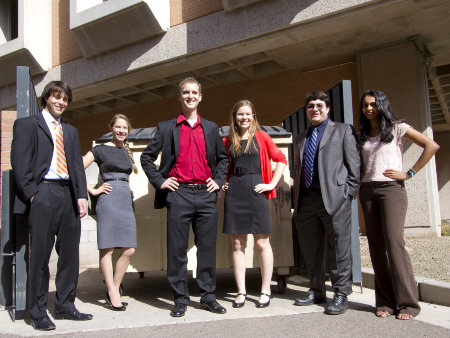Students At Imagine Cup Develop Flash Food

Hefty amount of perfectly uneaten food is wasted on daily basis by the restaurants while millions of people go to sleep hungry. But now feeding the hungry is now possible as a group of students has come up with a social media-powered project – Flash Food – that takes care of hungry people and minimizes food waste. The project will be placed in Microsoft’s Imagine Cup, which is scheduled to be organized next week in Sydney. The competition is hosted by Microsoft where students from across the globe are encouraged to participate and use their skills to address global issues like education, global warming, poverty and healthcare access.
The project is developed by six genius minds from Arizona State Universit; Ramya Baratam, Steven Hernandez, Katelyn Keberle, Eric Lehnhardt, Loni Amundson, and Jake Irvin. All those restaurants, hotels, cafes and catering companies that use the project’s mobile app or company’s website have to notify that they have the food ready for pickup. All the NGOs and other social activists who work for community organizations can respond to the notifications and visit to collect the food. People who need a meal and are registered with the app can then receive notification about the availability of the food.
Once a restaurant is registered, it can display the seal on websites, menus, and social media channels and through this process it can tell people about their commitment to corporate responsibility. There is an option of searchable database on Flash Food’s website through which people can find out which restaurant has participated in this global cause. It is also expected in the future that consumers will start searching on Yelp just for restaurants that are registered with Flash Food.
Lhnhardt says food providers can get many benefits from Flash Food certification. “No one wants to see food go to waste, especially when you know there are people in your community who would love to be able to receive that food,” he says.
Flash Food follows all the rules and guidelines to provide people with healthy food, and prevent them from getting sick and eating stale food. “It’s like pizza delivery,” says Lehnhardt, “As long as it’s kept in a hot sleeve and above a certain temperature while it’s in transit, it’s safe to eat.”
Although the project is still in pilot stage but it has already made its name in the United States’ Imagine Cup. The team is hopeful to launch this project by 2013.
“Flash Food is not the end-all-be-all solution to end hunger in urban areas,” said Lehnhardt. “The project is aimed to help the needy and we require participation at the community level to work with us and find out more solutions,” he added.







